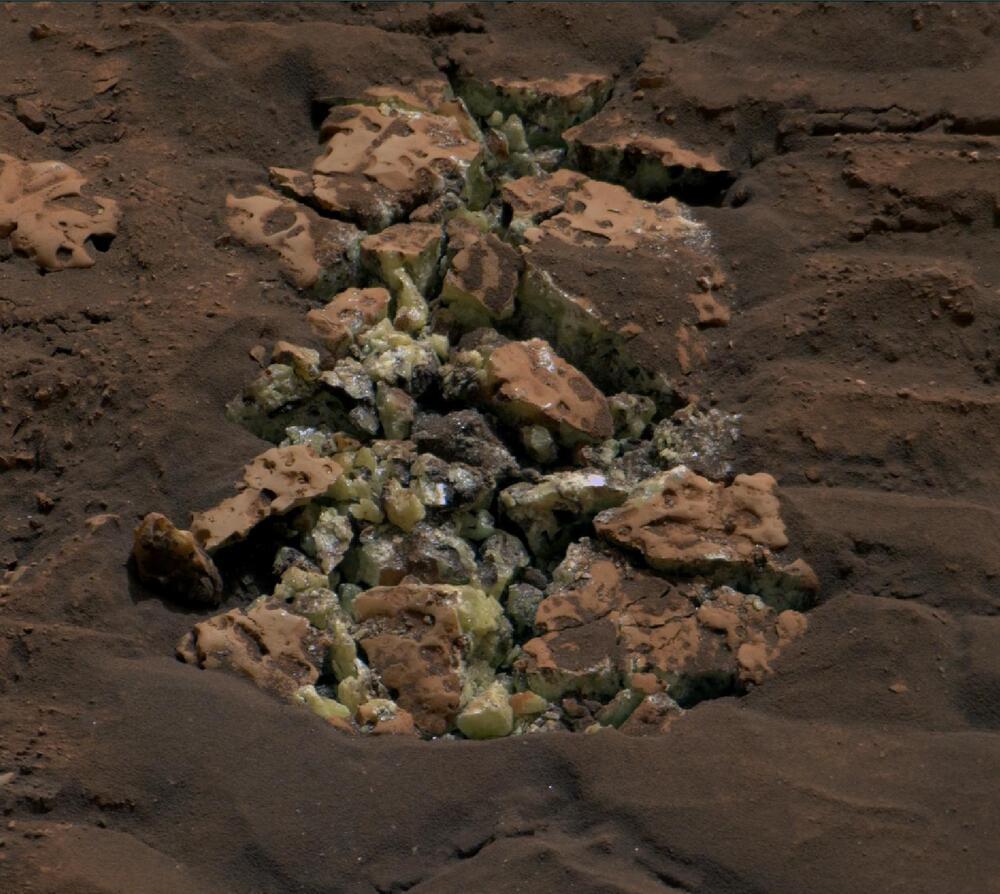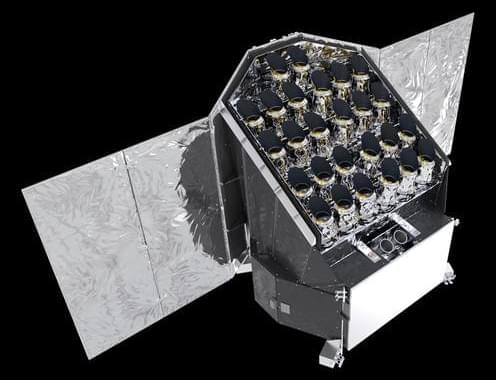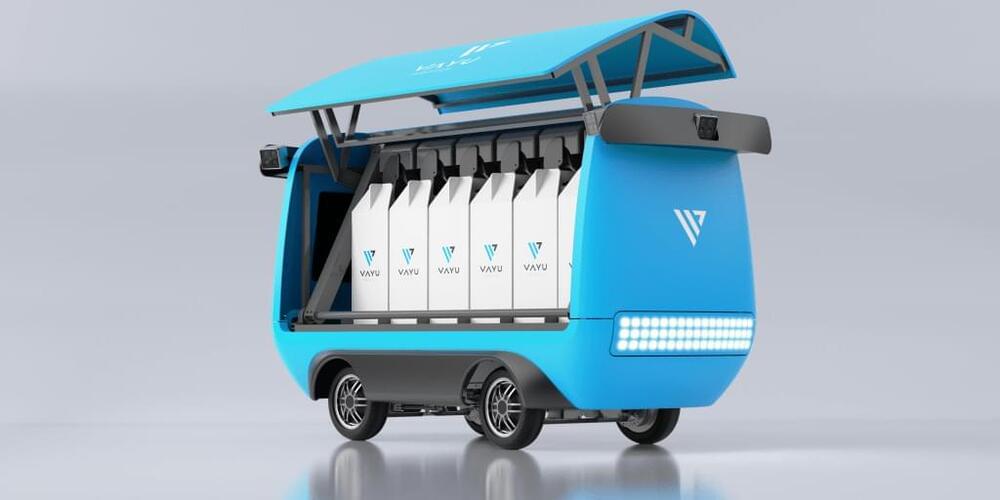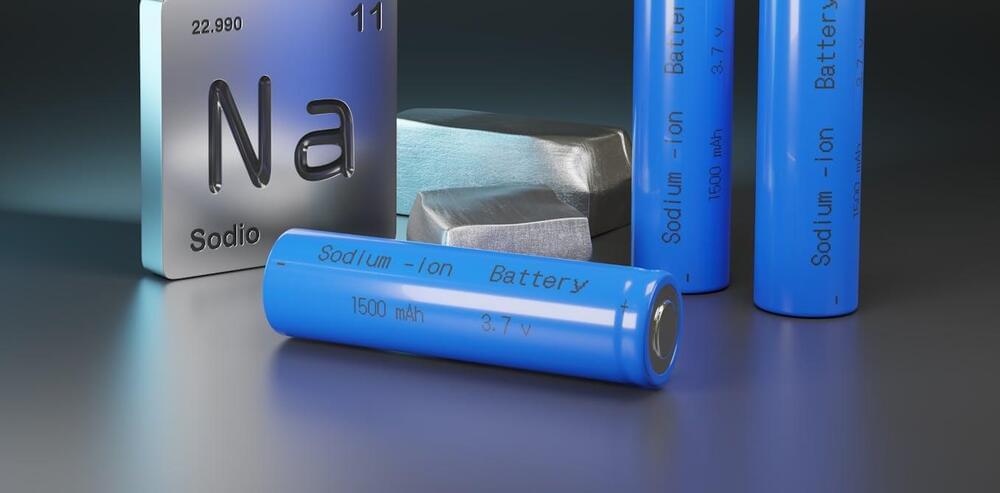Page 520
Jul 23, 2024
Mars Surprise: Rover Discovers Pure Sulfur Rocks
Posted by Laurence Tognetti, Labroots Inc. in categories: robotics/AI, space
Did life ever exist on Mars, and if so, how did it get there? This is the goal of NASA’s Curiosity rover, which has traversed Gale Crater on Mars since 2012. But a recent finding by the car-sized robotic explorer could help bring scientists one step closer to answering these questions as Curiosity sent back images of yellow crystals revealed to be deposits of elemental sulfur, along with an entire field of them. This finding was accidentally “un-earthed” as Curiosity drove over them during its excursions. While scientists didn’t anticipate finding elemental sulfur in this region, this finding could hold the potential to help piece together the geologic history of Gale Crater and whether life once existed there.
Recent image of elemental sulfur crystals obtained by NASA’s Curiosity rover on Mars. (Credit: NASA/JPL-Caltech/Malin Space Science Systems)
“Finding a field of stones made of pure sulfur is like finding an oasis in the desert,” said Dr. Ashwin Vasavada, who is a project scientist on Curiosity at NASA’s Jet Propulsion Laboratory. “It shouldn’t be there, so now we have to explain it. Discovering strange and unexpected things is what makes planetary exploration so exciting.”
Jul 23, 2024
UK, Italy, Japan’s 6th-gen fighter could feature AR, laser weapons
Posted by Raphael Ramos in categories: augmented reality, military

The fighter’s new engines can power laser weapons and enable a “pilot optional” mode.
This website is using a security service to protect itself from online attacks. The action you just performed triggered the security solution. There are several actions that could trigger this block including submitting a certain word or phrase, a SQL command or malformed data.
Jul 23, 2024
Europe’s PLATO Telescope: Hunting Earth-like Planets Beyond Our Solar System
Posted by Laurence Tognetti, Labroots Inc. in category: space
How many Earth-like planets exist throughout the universe? This is what recent talk given at the National Astronomy Meeting 2024 hopes to address as Dr. David Brown, who is a scientist on the European Space Agency’s (ESA) PLATO (PLAnetary Transits and Oscillations of stars) mission, provided an update on the mission and the goals it hopes to achieve. This comes as PLATO is currently scheduled to launch in December 2026 with the goal of finding Earth-like planets throughout the universe, which could greatly expand our knowledge of exoplanets, as well.
“PLATO’s goal is to search for exoplanets around stars similar to the Sun and at orbital periods long enough for them to be in the habitable zone,” said Dr. Brown. “One of the main mission objectives is to find another Earth-Sun equivalent pair, but it is also designed to carefully and precisely characterize the exoplanets that it finds (i.e. work out their masses, radii, and bulk density).”
Jul 23, 2024
The Far Out Initiative interviews David Pearce
Posted by Sergio Tarrero in category: futurism
Jul 23, 2024
Ex-Apple car engineers’ startup Vayu offers autonomous delivery robots sans Lidar sensors
Posted by Cecile G. Tamura in categories: robotics/AI, transportation
Vayu is already witnessing significant traction, with as many as 20 enterprises piloting it’s novel technology and over 100 on a waitlist.
Jul 23, 2024
Tissue Nanotransfection Silicon Chip and Related Electroporation-Based Technologies for In Vivo Tissue Reprogramming
Posted by Quinn Sena in categories: biotech/medical, computing, mobile phones, neuroscience
Nanotransfection is very useful and could be used as a way to heal oneself on a smartphone in one touch with cell reprogramming and much more like gene transfer.
Tissue nanotransfection (TNT), a cutting-edge technique of in vivo gene therapy, has gained substantial attention in various applications ranging from in vivo tissue reprogramming in regenerative medicine, and wound healing to cancer treatment. This technique harnesses the advancements in the semiconductor processes, facilitating the integration of conventional transdermal gene delivery methods—nanoelectroporation and microneedle technologies. TNT silicon chips have demonstrated considerable promise in reprogramming fibroblast cells of skin in vivo into vascular or neural cells in preclinical studies to assist in the recovery of injured limbs and damaged brain tissue. More recently, the application of TNT chips has been extended to the area of exosomes, which are vital for intracellular communication to track their functionality during the wound healing process.
Jul 23, 2024
Creating loops of liquid lithium for fusion temperature control
Posted by Shailesh Prasad in categories: engineering, nuclear energy, particle physics
Fusion vessels have a Goldilocks problem: The plasma within needs to be hot enough to generate net power, but if it’s too hot, it can damage the vessel’s interior. Researchers at the Princeton Plasma Physics Laboratory (PPPL) are exploring ways to draw away excess heat, including several methods that use liquid metal.
One possibility, say researchers at the U.S. Department of Energy Lab, involves flowing liquid lithium up and down a series of slats in tiles lining the bottom of the vessel. The liquid metal could also help to protect the components that face the plasma against a bombardment of particles known as neutrons.
“The prevailing option for an economical commercial fusion reactor is a compact design,” said PPPL’s Egemen Kolemen, co-author of a 2022 paper on the research and an associate professor of mechanical and aerospace engineering and the Andlinger Center for Energy and the Environment. However, compactness makes handling the heat flux and neutron bombardment a bigger challenge.
Jul 23, 2024
Sodium-ion batteries are set to spark a renewable energy revolution — and Australia must be ready
Posted by Shailesh Prasad in categories: government, nuclear energy, sustainability
The challenges posed by solar and wind generators are real. They are inherently variable, producing electricity only when the sun is shining and the wind is blowing. To ensure reliable energy supplies, grids dominated by renewables need “firming” capacity: back-up technology that can supply electricity on demand.
Some, including the Albanese government, argue gas-fired generators are needed to fill the gap. Others, such as the Coalition, say renewables can’t “keep the lights on” at all and Australia should pursue nuclear energy instead.
But a new way to firm up the world’s electricity grids is fast developing: sodium-ion batteries. This emerging energy storage technology could be a game-changer – enabling our grids to run on 100% renewables.
Jul 23, 2024
Physicists uncover key to resolving long-standing inertial confinement fusion hohlraum drive deficit
Posted by Shailesh Prasad in categories: energy, physics
“Significant effort has been invested over the years to pinpoint the physical cause of the radiation drive-deficit problem,” Chen said. “We are excited about this discovery as it helps resolve a decade-long puzzle in ICF research. Our findings point the way to an improvement in the predictive capabilities of simulations, which is crucial for the success of future fusion experiments.”
In NIF experiments, scientists use a device called a hohlraum—approximately the size of a pencil eraser—to convert laser energy into X-rays, which then compress a fuel capsule to achieve fusion.
For years, there has been a problem where the predicted X-ray energy (drive) was higher than what was measured in experiments. This results in the time of peak neutron production, or “bangtime,” occurring roughly 400 picoseconds too early in simulations. This discrepancy is known as the “drive-deficit” because modelers had to artificially reduce the laser drive in the simulations to match observed bangtime.
















